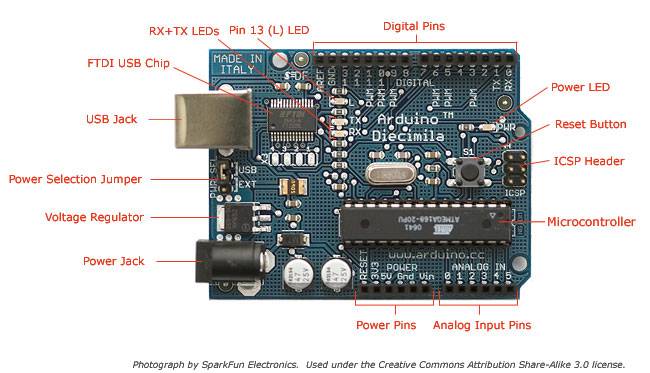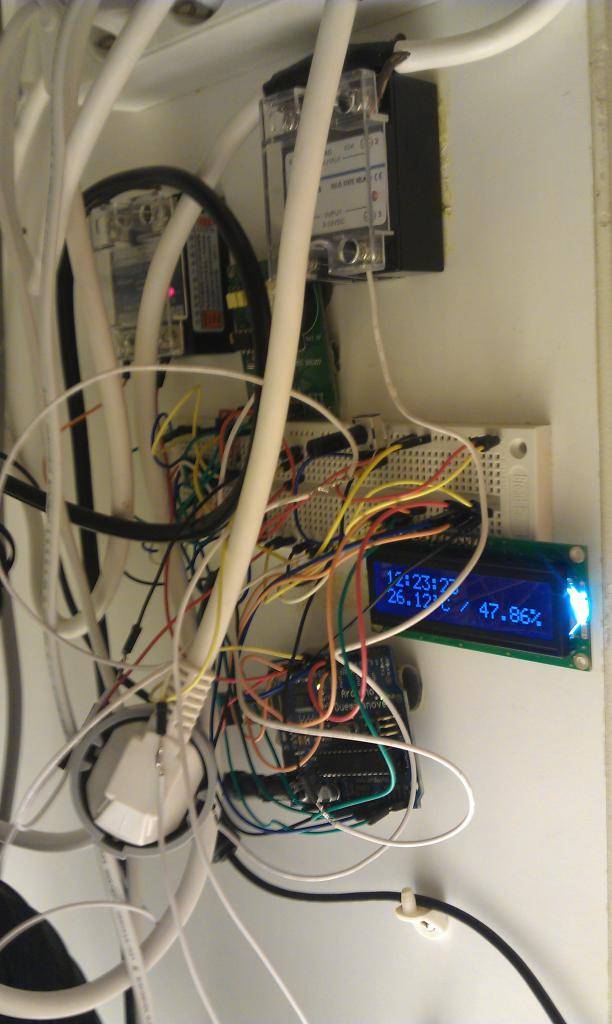Arduino what?
Arduino is a 16MHz Microcontroller with 30 kB of programmable memory and 1024 BYTES of RAM + another 1024 bytes of EEPROM, which you can consider being a sort of "hard disk" -- very small, very slow one.

In a sense, very, very slow computer with very, very limited capabilities. But in exchange, you get to hardware level. You get to control the actual hardware. Play with bits, bytes and voltages.
Arduino has digital inputs/outputs that can be used for communication and control. I can for example attach sensors that read the environment, and other more complicated devices such as a Clock. Or more memory. Pretty much anything you can think of that is found in any electronic device. Think of 256 colour touch screen - I could make touch controlled grow room with beautiful graphics, that's something.
There are also analog inputs which read voltage, which can be interpreted using software. I got humidity sensor in analog port. And in software I turn the raw humidity into relative humidity taking temperature into account.
Principles
I have programmed control logic using C / C++. That logic reads the environment and makes decisions based on rules I have programmed. Say, temperature is high => turn on ventilation. Or humidity is low => turn on humidifier. Actual logic is a bit more complicated than that, but that's the principle. Most recent addition is control based on time. So, as lights come on at certain time, I can let temperature get higher. At night, I want to keep temperature and humidity low. If I had CO2, I could do even better things! Please send me some.. Watering based on soil moisture is also coming some time.
Based on decisions made, devices are turned on or off. Devices [230 Volts] are controlled using Solid State Relays [SSR]. These are good upto 480 Volts and 40 Amps, so no problem what ever device I got. Although, expensive and large, so I have decided to switch all but light from SSR to more convinient and simpler 250VAC/10A devices. 8 relays so I can control whooooooooooooooole bunch of things.
Live Data in my Browser
But that's not enough! Not for me. Gladly Arduino can be connected to a PC using USB. I just happen to have a big Linux box at the same Location, so I have tapped my grow room into that.
Currently I can only READ data from it, but I am guessing I will be making a sort of "remote control" later on
I'm using JavaScript library called Highcharts to draw live graphs about the temperature and humidity and status of all devices. It also shows alerts if something isn't in check. Then with remote control I could actually turn the vent on sitting on my computer if the programmed-in logic isn't for some reason doing what I want. Or program more advanced logic. Open a door to let sunshine in to save money on energy.. Geeh. OR! Receive SMS messages to my mobile when things go HORRIBLY wrong, and then, switch all the electricity off. I might be either intelligent, or simply obsessive..
Live Status

Two days fiddling with Highcharts. The sun there is telling me lights are on. No need to walk there to make sure.
Funny to see also how temperature inversely correlates with humidity That data I can use to fine tune the logic.
That data I can use to fine tune the logic.
The Hardware

Really, really dirty. I want to get this pretty, maybe even solder all onto a breadboard once I have come up with something final.
The Future & Benefits
Umm.. So much to do! I love the idea of getting visual representation of data and grow environment. Using that I can make adjustments to logic and the cabinet itself.
Removing human component should make the grow go smoother. Humidity stays consistent, temperature stays consistent, and if and when I have the automated watering, that too.
I have some kind of vision of intelligent logic in which I set some parameters to each environmental variable and then the controller does its magic using what ever device it sees best fitting to meet those parameters. But that's quite an advanced logic and would require hell of lot of rules and thinking. Priorities and such.
It's truly unbelievable what one could do with this kind of stuff if one has imagination and ingenuity.
Will be posting updates.
Arduino is a 16MHz Microcontroller with 30 kB of programmable memory and 1024 BYTES of RAM + another 1024 bytes of EEPROM, which you can consider being a sort of "hard disk" -- very small, very slow one.
In a sense, very, very slow computer with very, very limited capabilities. But in exchange, you get to hardware level. You get to control the actual hardware. Play with bits, bytes and voltages.
Arduino has digital inputs/outputs that can be used for communication and control. I can for example attach sensors that read the environment, and other more complicated devices such as a Clock. Or more memory. Pretty much anything you can think of that is found in any electronic device. Think of 256 colour touch screen - I could make touch controlled grow room with beautiful graphics, that's something.
There are also analog inputs which read voltage, which can be interpreted using software. I got humidity sensor in analog port. And in software I turn the raw humidity into relative humidity taking temperature into account.
Principles
I have programmed control logic using C / C++. That logic reads the environment and makes decisions based on rules I have programmed. Say, temperature is high => turn on ventilation. Or humidity is low => turn on humidifier. Actual logic is a bit more complicated than that, but that's the principle. Most recent addition is control based on time. So, as lights come on at certain time, I can let temperature get higher. At night, I want to keep temperature and humidity low. If I had CO2, I could do even better things! Please send me some.. Watering based on soil moisture is also coming some time.
Based on decisions made, devices are turned on or off. Devices [230 Volts] are controlled using Solid State Relays [SSR]. These are good upto 480 Volts and 40 Amps, so no problem what ever device I got. Although, expensive and large, so I have decided to switch all but light from SSR to more convinient and simpler 250VAC/10A devices. 8 relays so I can control whooooooooooooooole bunch of things.
Live Data in my Browser
But that's not enough! Not for me. Gladly Arduino can be connected to a PC using USB. I just happen to have a big Linux box at the same Location, so I have tapped my grow room into that.
Currently I can only READ data from it, but I am guessing I will be making a sort of "remote control" later on

I'm using JavaScript library called Highcharts to draw live graphs about the temperature and humidity and status of all devices. It also shows alerts if something isn't in check. Then with remote control I could actually turn the vent on sitting on my computer if the programmed-in logic isn't for some reason doing what I want. Or program more advanced logic. Open a door to let sunshine in to save money on energy.. Geeh. OR! Receive SMS messages to my mobile when things go HORRIBLY wrong, and then, switch all the electricity off. I might be either intelligent, or simply obsessive..
Live Status
Two days fiddling with Highcharts. The sun there is telling me lights are on. No need to walk there to make sure.
Funny to see also how temperature inversely correlates with humidity
The Hardware
Really, really dirty. I want to get this pretty, maybe even solder all onto a breadboard once I have come up with something final.
The Future & Benefits
Umm.. So much to do! I love the idea of getting visual representation of data and grow environment. Using that I can make adjustments to logic and the cabinet itself.
Removing human component should make the grow go smoother. Humidity stays consistent, temperature stays consistent, and if and when I have the automated watering, that too.
I have some kind of vision of intelligent logic in which I set some parameters to each environmental variable and then the controller does its magic using what ever device it sees best fitting to meet those parameters. But that's quite an advanced logic and would require hell of lot of rules and thinking. Priorities and such.
It's truly unbelievable what one could do with this kind of stuff if one has imagination and ingenuity.
Will be posting updates.





